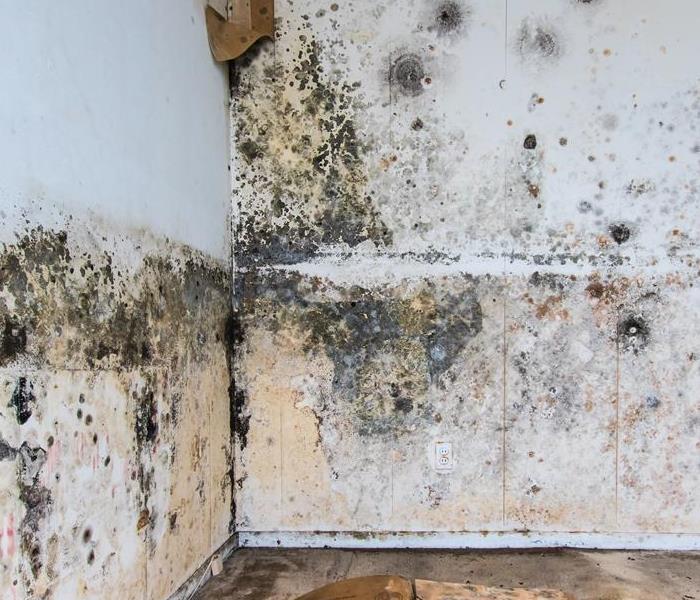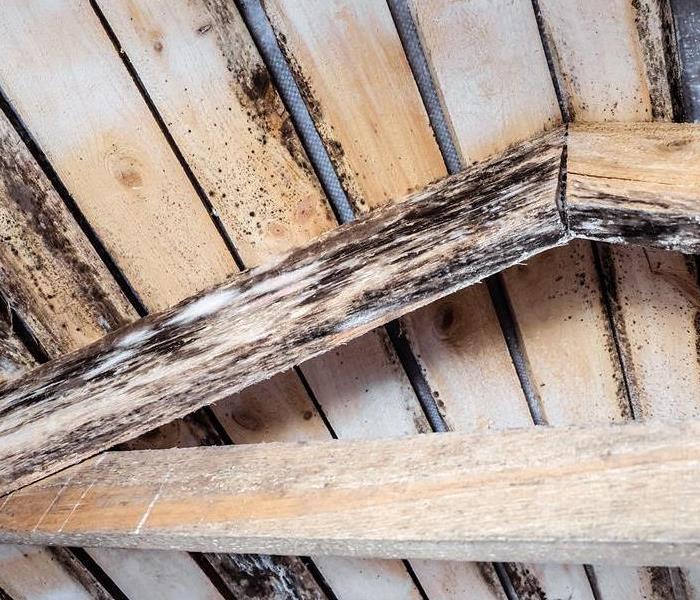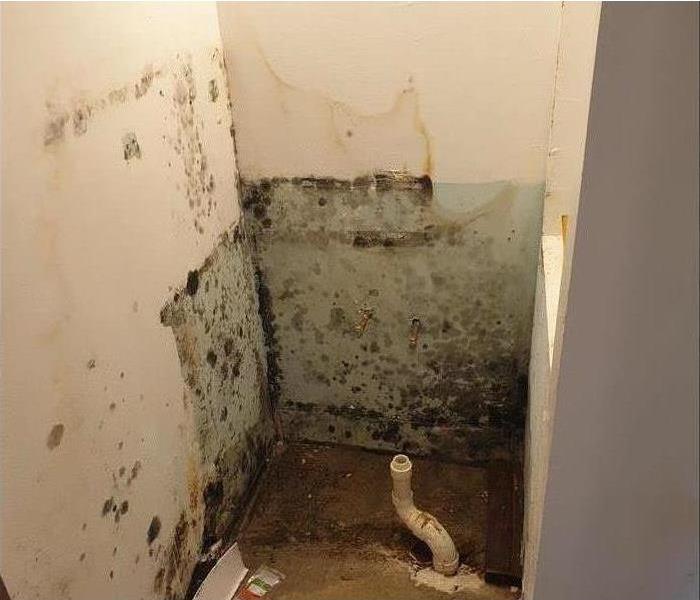Recent Mold Remediation Posts
Shielding Your Home: Mold Prevention Tips Every Homeowner Should Know
3/6/2024 (Permalink)
Mold prevention is a fundamental aspect of homeownership that goes beyond health considerations. Mold, a common household intruder, can cause structural damage and diminish the aesthetic appeal of your residence. In this blog, we'll delve into essential mold prevention tips tailored for every homeowner, focusing on the non-health-related aspects to foster a resilient living environment.
Maintain Optimal Indoor Humidity
Keep indoor humidity levels in check, aiming for levels below 60%. Use dehumidifiers in damp areas like basements and bathrooms to create an environment less conducive to mold growth.
Act swiftly to repair any water leaks in your home. Leaky roofs, plumbing issues, or malfunctioning appliances can create moisture pockets ideal for mold. Timely repairs mitigate the risk of mold-friendly conditions.
Ensure Proper Ventilation
Adequate ventilation is crucial in preventing mold growth. Use exhaust fans in bathrooms and kitchens to reduce humidity, and ensure that attics and crawl spaces are well-ventilated to discourage moisture buildup.
Gutters and Outdoor Foundation
Keep gutters and downspouts free of debris, ensuring proper drainage away from your home's foundation. Well-maintained gutters prevent water accumulation and reduce the risk of moisture-related problems.
Seal any cracks or openings in walls, windows, and the foundation to prevent water intrusion and limit the entry points for mold spores.
Landscaping with Mold Prevention in Mind
Plan your landscaping to minimize mold-friendly conditions. Avoid planting shrubs too close to the home, as this can limit air circulation and create shaded, damp areas conducive to mold growth.
Ensure the ground around your home slopes away from the foundation. This simple measure helps prevent water accumulation near the structure, reducing the risk of moisture seepage.
Regular Cleaning and Dusting
Establish a regular cleaning routine to remove dust, dirt, and potential mold spores. Pay extra attention to high-moisture areas like bathrooms and kitchens. Arrange furniture to optimize airflow and prevent moisture buildup in confined spaces. Adequate ventilation reduces the risk of mold growth in hidden corners. Store items with proper spacing in well-ventilated areas. This practice allows air circulation and minimizes the risk of mold growth on stored items.
Roof Maintenance
Schedule regular roof inspections and maintenance to address any potential leaks. A well-maintained roof is a key element in preventing water intrusion and subsequent mold-related issues.
Indoor Appliances
Appliances like clothes dryers and stoves should be properly ventilated to the outside. This prevents the buildup of excess moisture in indoor spaces. If you have indoor plants, be mindful of watering practices. Avoid overwatering and use well-draining soil to prevent excessively humid conditions that mold thrives on.
Implementing these mold prevention tips is a proactive investment in the longevity and aesthetic appeal of your home. By fostering an environment that is less conducive to mold growth, you're not only shielding your property from potential structural damage but also ensuring a resilient and welcoming living space for years to come.
Mold prevention is an ongoing commitment to the well-being of your home, enhancing its durability and maintaining its visual allure.
The Importance of Mold Inspections in Preventing Infestations
10/24/2023 (Permalink)
 Mold inspections are important to ensure your home is safe. Invest in inspections and early detection.
Mold inspections are important to ensure your home is safe. Invest in inspections and early detection.
Mold infestations can cause significant damage to your home and impact its structural integrity. In this blog, we will explore the importance of mold inspections in identifying and preventing mold growth. By understanding the value of regular mold inspections, you can take proactive measures to safeguard your home and maintain a clean and healthy living environment.
Early Detection
Regular mold inspections play a crucial role in early detection. Mold can often grow undetected in hidden areas such as behind walls, underneath flooring, or in crawl spaces. By conducting periodic inspections, trained professionals can spot signs of mold growth before it becomes a widespread problem. Early detection allows for timely intervention and prevents the need for extensive and costly remediation later on.
Identifying Underlying Issues
Mold growth is often an indicator of underlying issues in a home's infrastructure, such as leaks, poor ventilation, or water damage. Mold inspections can help identify these issues, allowing homeowners to address them promptly. By identifying and rectifying the root cause of mold growth, you can prevent future infestations and potentially save money on repairs down the line.
Protecting Indoor Air Quality
Mold can release spores into the air, which can impact indoor air quality. Even if you can't see visible mold growth, it doesn't mean there isn't an issue. Mold inspections can help identify areas with high mold spore counts or hidden mold activity, allowing you to take appropriate measures to improve and maintain good indoor air quality. This is especially important for individuals with allergies or respiratory conditions who may be more susceptible to the effects of poor air quality.
Peace of Mind
Regular mold inspections provide homeowners with peace of mind. By knowing that your home has been thoroughly examined for mold growth, you can feel confident in the safety and well-being of your living environment. Mold inspections can help alleviate concerns about hidden mold and potential damage to your home, allowing you to focus on enjoying your living space without worry.
Maintaining Property Value
Regular mold inspections can help preserve and even enhance the value of your property. Mold infestations, if left unchecked, can cause significant damage to the structure and aesthetics of your home. This can lead to costly repairs and renovations, resulting in a decrease in property value. By conducting mold inspections, you can identify and address mold issues before they escalate, ensuring that your property remains in good condition. Additionally, if you ever decide to sell your home, having a history of regular mold inspections and a clean bill of health can be an attractive selling point for potential buyers, instilling confidence in the overall quality and maintenance of the property.
Mold inspections are an integral part of maintaining a clean and healthy home. By investing in regular inspections, you can detect mold growth in its early stages, identify underlying issues that contribute to mold infestation, protect your indoor air quality, and enjoy peace of mind in knowing that your home is free from harmful mold. Preventative measures through inspections can save you time, money, and potential headaches down the road.
7 Essential Mold Prevention Tips for Attics and Crawl Spaces: Keep Your Home Healthy and Mold-Free!
5/17/2023 (Permalink)
 Preventing mold from growing in your attic is crucial for maintaining a healthy home.
Preventing mold from growing in your attic is crucial for maintaining a healthy home.
Mold is a common problem that can occur in attics and crawl spaces of homes. It can be unsightly, produce a musty odor. Mold thrives in damp and dark environments, which makes attics and crawl spaces susceptible to mold growth. Fortunately, there are several mold prevention tips that homeowners can follow to keep their attics and crawl spaces mold-free. In this blog post, we will explore some effective mold prevention strategies for attics and crawl spaces.
Keep Moisture in Check
The most important step in preventing mold in attics and crawl spaces is to control moisture. Mold needs moisture to grow, so it's crucial to keep these areas dry. Inspect your attic and crawl space regularly for any signs of water leaks, condensation, or dampness. If you notice any issues, address them immediately to prevent mold growth. Fix any leaks in the roof, walls, or plumbing, and ensure that gutters and downspouts are working properly to divert water away from your home.
Improve Ventilation
Proper ventilation is essential for preventing mold in attics and crawl spaces. Without adequate airflow, moisture can become trapped and create a conducive environment for mold growth. Install vents in your attic and crawl space to promote air circulation. Roof vents, soffit vents, ridge vents, and gable vents are common types of vents that can be installed to improve ventilation. Additionally, make sure that your attic and crawl space vents are not blocked by debris or insulation.
Insulate Properly
Insulation is another key factor in mold prevention. Insulate your attic and crawl space properly to reduce condensation and prevent moisture from entering these areas. Use insulation materials that are resistant to moisture, such as closed-cell spray foam insulation or rigid foam insulation. Avoid using cellulose or fiberglass insulation in areas that are prone to moisture, as they can absorb water and promote mold growth.
Monitor Humidity Levels
Monitoring humidity levels in your attic and crawl space can help prevent mold growth. The ideal humidity level for these areas is below 50%. Use a hygrometer to measure the humidity levels and invest in a dehumidifier if necessary to keep the humidity in check. Make sure to empty the dehumidifier regularly and clean it to prevent mold growth inside the unit.
Keep the Area Clean and Dry
Regular cleaning and maintenance can go a long way in preventing mold in attics and crawl spaces. Keep these areas clean and free from debris, dust, and dirt. If you notice any signs of mold, such as black spots or a musty smell, clean it immediately using a mold cleaner or a mixture of water and detergent. Dry the area thoroughly after cleaning to prevent moisture from lingering.
Use Mold-Resistant Products
When renovating or building a new home, consider using mold-resistant products in your attic and crawl space. Mold-resistant drywall, insulation, and paint can help inhibit mold growth and provide an extra layer of protection against mold. These products are specifically designed to resist moisture and prevent mold from taking hold in your attic or crawl space.
Seek Professional Help
If you are unsure about how to prevent mold in your attic or crawl space, or if you suspect a mold problem that is beyond your control, it's best to seek professional help. Mold remediation experts can assess the condition of your attic and crawl space, identify the source of the moisture, and provide appropriate solutions to prevent mold growth.
In conclusion, mold prevention in attics and crawl spaces is crucial for maintaining a healthy home environment. By keeping moisture in check, improving ventilation, insulating properly, monitoring humidity levels, keeping the area clean and dry.
Mold Remediation After a Flood
12/14/2022 (Permalink)
 Mold cleanup is only one call away
Mold cleanup is only one call away
When you have a flood, it's important to get the water out of your home as quickly as possible. But that's just the first step—you still need to deal with any mold growth that was caused by the flood. We've put together this guide on how to remove mold after a flood in order to help you recover quickly and safely after your disaster.
Protect Yourself
When you're at an Affton, MO home or office after a flood, it is important to wear long sleeves, pants and gloves to protect your skin. You should also wear goggles when cleaning up any standing water in order to protect your eyes from dust particles. Note that your socks and shoes will likely have mold growing on them after being exposed, so be sure to take those off before entering mold free areas. You may also want to consider wearing a respirator mask if there are high levels of airborne particles that can be inhaled into the lungs (such as after a flood).
Check Thoroughly for Mold
You will need to check thoroughly for mold. Mold can grow in tiny, hard-to-see places. Be sure you are checking all throughout the house to ensure you don’t miss any:
- Check the backs of cabinets.
- Look in hidden areas like behind the refrigerator, under sinks and in crawl spaces.
- Check for mold in hard-to-reach places like behind a wall or under the floorboards.
- Do not neglect to check for mold on your walls and ceilings if you have water damage from a flood or leaky pipes.
Get Ready to Clean
After the flood, you’ll want to start cleaning up as quickly as possible. Mold can grow at an alarming rate and soon spread throughout your home in ways that are difficult to contain.
A good scrubbing brush or sponge will help remove mold from surfaces such as drywall or plywood. Use hot water mixed with detergent to clean these areas thoroughly, paying special attention to any stains where water may have been trapped for a long time. If possible, wear gloves and protective clothing (like long sleeves) so that you don’t come into contact with any mold spores yourself during the cleanup process! If you do end up getting some on your skin, wash it off immediately with soap and water before it has a chance to get into your system through open cuts.
Goggles should also be worn when dealing with any kind of cleanup project inside—these keep your eyes protected against airborne particles without obscuring vision too much for safety reasons! A respirator mask is recommended if there's more than just light dusting around (more than 1/4 inch thick).
Dealing with Porous Materials
You'll have to decide what to do with your porous materials. Porous materials like wood flooring, drywall, or ceiling tiles that have been wet for more than 48 hours should be thrown away. You can clean and dry carpets within 24 hours—but if you have carpeting it is important to get it cleaned as soon as possible (within 24 hours) so that mold does not grow in the fibers of your carpet.
It's important to take care of any mold growth in your house as soon as possible. If left alone, mold will continue to grow and spread throughout your home—so it's crucial that you remove it quickly and completely. If you suspect that you have a recurring issue with mold growth or if there is a history of flooding in your area, consider hiring an expert to check up on your home regularly. Your professional should be able to find any signs of water damage or potential sources for future leaks (such as faulty plumbing) so they can be repaired before they cause further damage.
Now that you know how to deal with mold, you can put the power in your hands to prevent it from growing on your property. Remember that prevention is key when dealing with this issue because once you have a mold problem, it’s difficult to completely get rid of and may take months or even years before it goes away completely. When you have a serious mold problem in your home or business, the best course of action is to call SERVPRO of Affton/Webster Groves!





 24/7 Emergency Service
24/7 Emergency Service


